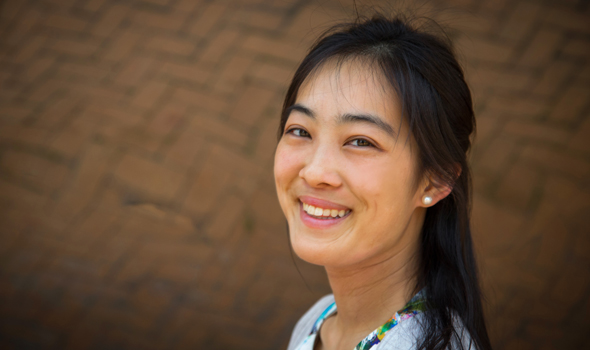STEM + HUMANITIES AT MIT
Meet Cara Lai '16, who cites studies in MIT Literature as key to her preparation for medical practice

"What is the truth? How do you interpret someone's story? These questions get asked all the time in medicine — and they are also asked all the time in literature. The study of literature is about the experience of being human, and that's inseparable from the practice of medicine."
— Cara Lai '16, Literature and Mechanical Engineering
Gallery | Meet the MIT Bilinguals
Cara Lai '16, who arrived at MIT focused on engineering studies, soon discovered that the breadth and depth of an MIT education is designed to help students explore new fields, discover connections between disciplines, and to find their callings.
As a result, Lai will graduate this spring with a double major — in Literature and Mechanical Engineering — and next fall will enter the Stanford University School of Medicine. There she will draw on what she learned in both MIT's STEM and Humanities classes, most especially, she says, studies in MIT Literature, which provided her with tools critical to the practice of medicine.
Medicine and the experience of being human
"The body is in many ways a machine; it experiences wear and tear, has complex systems coupled together in specific interactions, and occasionally needs parts replaced," says Lai. "But, in very obvious ways humans are not machines, and that's where the humanities come in. The study of literature is about the experience of being human, and that's inseparable from the practice of medicine."
While Lai knew she would get an excellent engineering education at the Institute, she was initially concerned that her love of literature could be short-changed. "I felt like I might be giving up something coming to MIT because I was very interested in literature. But that did not turn out to be at all the case,” she says. "MIT's humanities programs are just stellar."
The doctor-patient relationship
At first, Lai pursued literature at MIT as a personal passion. She declared a major in mechanical engineering and prepared for a career working on medical devices — an interest she developed in high school while competing on a FIRST Robotics team. Her team was sponsored by Intuitive Surgical, which introduced her to the Da Vinci robotic surgical system, and that in turn inspired her interest in medical engineering.
Then, during MIT's Independent Activities Period sophomore year, Lai got the chance to shadow Dr. John Lamberti, an MIT alumnus and chief of the Cardiovascular Surgery Division at Rady Children's Hospital in San Diego. It was during that time that she discovered she really wanted to treat patients. "I think there will always be something about the doctor-patient relationship that's sacred," she says. "That's why I'm doing this instead of medical devices."
Interpreting patients' stories
And, while medicine requires a great deal of technical skill, Lai notes that it's also a field in which human context deeply matters — who the patient is, where he or she came from, and who the family members are. "People expect medicine to be black and white," she observes, "like engineering. Engineering is super black and white. If you have to make a tough decision, you weigh numbers against each other. But medicine isn't always that way."
Medicine is about human relationships, and building relationships requires an ability to empathize with patients — even those who come from very different backgrounds. That's where literature provides critical support, Lai says. "In fiction, great authors craft characters who are people — you can inhabit their lives. You start to empathize with them. In life, you can then draw these connections," she says.
Since doctors have little time to learn about their patients, it is very useful to develop an understanding of how stories work, Lai says. "What is the truth? How do you interpret someone's story? These questions get asked all the time in medicine — and they are also asked all the time in literature."
An enduring source
Double-majoring in mechanical engineering and literature — while also fulfilling premed requirements— kept Lai busy with classes, but she also participated in other opportunities at MIT. She spent half of her junior year at Oxford University in England studying Victorian literature, and went to Spain to study Spanish literature on a Kelly-Douglas Traveling Fellowship.
Going forward, Lai says she plans to continue her study of literature at Stanford because she enjoys the "layers of perspective" she gains from reading and sharing insights with professors and fellow students. "There's so much you can learn from books. It never ends," she says.
Suggested Links
MIT Literature
MIT Literature Majors and Alumni
How to major, minor, or concentrate in Literature at MIT
Kelly Douglas Travel Fund
Story prepared by SHASS Communications
Editorial and Writing team: Emily Hiestand, Kathryn O'Neill
Photography: Jon Sachs
Published May 28, 2016